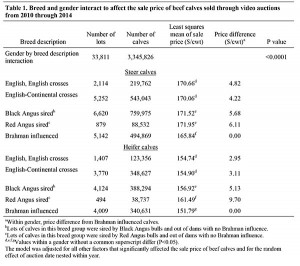In recent years, the sale price of beef calves has increased as a result of many factors. While the industry rebuilds the cowherd, there is more demand from producers for high quality females with maternal traits. There are fewer heifer calves sent to feedlots and more being retained for the cowherd. In addition, increased demand from consumers for beef as a source of protein contributes to the price of calves. There are many avenues producers can take to market their calves; auction markets, video auctions, private treaty, and branded beef programs are a few of the options. The objective was to quantify the effect of the potential interaction of breed and gender on sale price of beef calves marketed through video auctions while accounting for all other factors that significantly influenced price.
Information describing factors that could potentially affect the sale price of lots of beef calves that were marketed through a livestock video auction service (Superior Livestock Auction, Fort Worth, TX) was obtained from the auction service. These data were collected for all lots of beef calves that were offered for sale from 2010 through 2014
Breed description of the calves in the lots was 1 of 19 factors included in the original model and was characterized into five groups: English, English crosses, English–Continental crosses, Black Angus sired out of dams with no Brahman influence, Red Angus sired out of dams with no Brahman influence, and Brahman influenced.
The fixed effects included in the original models were year of sale, calf sex, whether the lot was a mixed-gender or single-sex lot, geographical location, breed description, health protocol, base weight variation within the lot, frame score, flesh score, presence of horns, Certified Natural program nested within implant status, Non-Hormone Treated Cattle program nested within implant status, age and source verified, whether the lot qualified for Superior progressive Genetics program, size of the lot (linear and quadratic terms), base weight (linear and quadratic terms), whether the lot qualified for Bovine Viral Diarrhea-Persistently Infected Free program, number of the days between auction and planned delivery, and the implant status. At each step of the backwards selection procedure, the variable with the largest P-value was eliminated from the model. A value of P<0.05 was used to include a fixed effect in the model. Of the 19 fixed effects, only 16 were significant and included in the final model.
 The data analyzed were collected from 116 livestock video auctions from 2010 to 2014. There were 2,106,181 total steer calves and 1,239,645 total heifer calves used in the analyses (Table 1). Breed and gender of the lot interacted to affect sale price of calves and was 1 of 16 factors that were significant in the final model. Implant status, number of days between auction and planned delivery, and calves that qualified for Bovine Viral Diarrhea-Persistently Infected Free program did not significantly affect the sale price of beef calves.
The data analyzed were collected from 116 livestock video auctions from 2010 to 2014. There were 2,106,181 total steer calves and 1,239,645 total heifer calves used in the analyses (Table 1). Breed and gender of the lot interacted to affect sale price of calves and was 1 of 16 factors that were significant in the final model. Implant status, number of days between auction and planned delivery, and calves that qualified for Bovine Viral Diarrhea-Persistently Infected Free program did not significantly affect the sale price of beef calves.
For the steer calves, lots of Red Angus and Black Angus sired steer calves had similar sale prices and sold for significantly higher prices than all other steer breed groups. English, English crossed and English-Continental crossed steer lots had similar sale prices but were greater than Brahman influenced steer calves.
Among heifer calves, lots of Red Angus heifers sold for the highest price. Black Angus sired heifer calves sold followed and sold for more than English -Continental crossed and English, English crossed heifers. Brahman influenced heifer calves sold for the lowest price compared with heifers of all other breed descriptions.
These data show the value differences of specific breed compositions of beef calves and the influence of gender. Price differences among breed of heifer calves may relate to supply and demand for use as replacements in the cowherd.